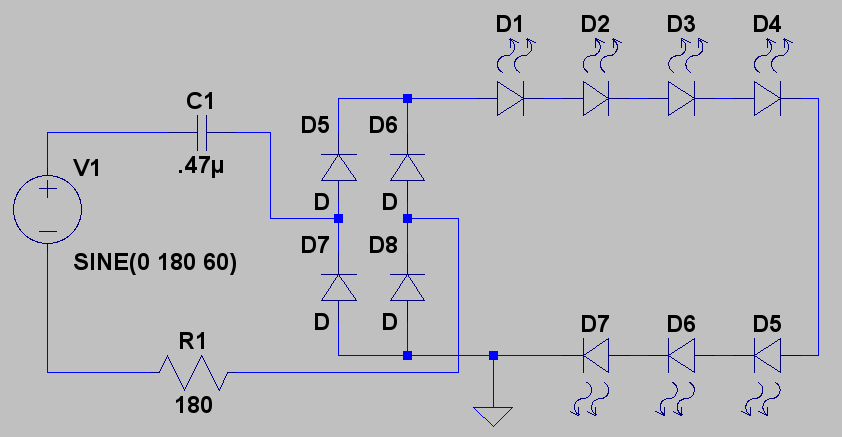
Animated LED for Bike Turning Signal

The circuit below demonstrates how to animate a bike turning signal using LEDs. The bike turning signal will blink sequentially from the right side (D1) to the left side (D5).
This circuit utilizes a series of light-emitting diodes (LEDs) arranged to represent the bike's turning signal. The sequence begins with LED D1, which represents the right turn signal, illuminating first. Following this, the signal progresses through LEDs D2, D3, and D4, before finally illuminating LED D5, which represents the left turn signal. This sequential blinking creates a visual effect that simulates a directional signal, enhancing the visibility of the bike's intentions to other road users.
To achieve this effect, a microcontroller or a timer IC can be employed to control the timing of the LED illumination. A simple microcontroller circuit can be programmed to turn each LED on and off in a specific sequence with defined time intervals between each activation. Alternatively, a 555 timer IC can be configured in astable mode to generate a pulse that drives a transistor or MOSFET, which in turn controls the LEDs.
The circuit may include current-limiting resistors for each LED to prevent excessive current from damaging the components. Additionally, a power supply appropriate for the LEDs and control circuitry must be provided, ensuring that the voltage and current ratings are within safe limits.
Overall, this design not only provides a functional turning signal for bicycles but also improves safety by making the bike more visible during turns, particularly in low-light conditions.Using circuit below, we can animate the bike turning signal using LED. The bike turning signal will blink from the right side (D1) to the left side (D5) in a.. 🔗 External reference
This circuit utilizes a series of light-emitting diodes (LEDs) arranged to represent the bike's turning signal. The sequence begins with LED D1, which represents the right turn signal, illuminating first. Following this, the signal progresses through LEDs D2, D3, and D4, before finally illuminating LED D5, which represents the left turn signal. This sequential blinking creates a visual effect that simulates a directional signal, enhancing the visibility of the bike's intentions to other road users.
To achieve this effect, a microcontroller or a timer IC can be employed to control the timing of the LED illumination. A simple microcontroller circuit can be programmed to turn each LED on and off in a specific sequence with defined time intervals between each activation. Alternatively, a 555 timer IC can be configured in astable mode to generate a pulse that drives a transistor or MOSFET, which in turn controls the LEDs.
The circuit may include current-limiting resistors for each LED to prevent excessive current from damaging the components. Additionally, a power supply appropriate for the LEDs and control circuitry must be provided, ensuring that the voltage and current ratings are within safe limits.
Overall, this design not only provides a functional turning signal for bicycles but also improves safety by making the bike more visible during turns, particularly in low-light conditions.Using circuit below, we can animate the bike turning signal using LED. The bike turning signal will blink from the right side (D1) to the left side (D5) in a.. 🔗 External reference





